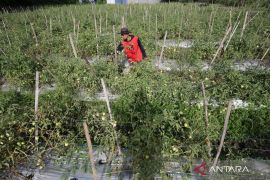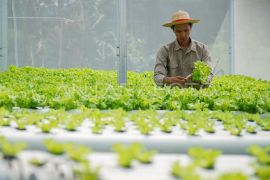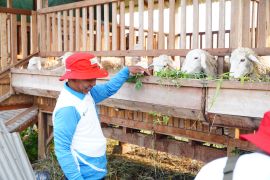The extreme dry season has affected several areas since May and is expected to last until September, with the condition likely to peak in August. In the beginning, dry spells were reported mostly on Java Island. Currently, drought has cast a pall over 100 districts and cities in the Aceh, West Java, Central Java, Yogyakarta, East Java, West Nusa Tenggara (NTB), and East Nusa Tenggara (NTT) provinces, the Indonesian Agriculture Ministry's data stated.
"Most parts of Java, Bali, and Nusa Tenggara have not received rains for over 30 days. Drought has affected some 100 districts and cities," Sarwo Edhy, director general for agriculture infrastructure and facilities at the Agriculture Ministry, revealed on July 8, 2019, following a coordinating meeting to discuss mitigation efforts.
The extreme dry season has impacted 102,746 hectares (ha) of agricultural area and ruined 9,358 ha. East Java is the worst hit, with 34,006 ha of rice fields having dried up, and 5,069 hectares spoilt; followed by 32,809 ha in Central Java going bone dry and 1,893 ha spoilt; and 25,416 hectares going dry and 624 hectares ruined in West Java. Yogyakarta has been ailing from the impact of the drought, with 6,139 ha going dry and 1,757 ha spoilt; 3,464 ha in Banten; 857 ha in NTB; and 55 ha in NTT, with 15 ha ruined.
Sumardjo Gatot Irianto, the ministry's director general for crops, affirmed that the ministry will accrue data on farmers covered under insurance, and the government will distribute seeds to farmers not having insurance cover.
He stressed the need to build more water pumps and wells; restore the irrigation system; and optimize the utilization of water from nearby rivers, lakes, and dams to cope with the impact of droughts. The agriculture ministry will also intensify the planting of crops on dry land. During such a dry season, it is time to plant in productive swamp areas, he suggested.
The capital city, Jakarta, has also been advised to be prepared for droughts. Rawa Badak and Rorotan in North Jakarta have gone for 30-61 days without rains.
In fact, in May and June 2019, some areas had experienced a shortage of water, according to the Head of Climate Information Analysis of BMKG, Adi Ripaldi, in Jakarta, on July 4. The people of Jakarta have been urged to use water wisely for every need, including irrigation and watering their plants.
In Karawang, West Java, nearly 23 thousand residents in 14 villages have been running short of clean water due to this year's drought.
To address this scarcity, the regional government-owned drinking water company, Tirta Tarum, has filled water tankers to distribute clean water to the villages. Similarly, the local environment and sanitation office will build water reservoirs to anticipate droughts in the Tegalwaru sub-district.
Meanwhile, the Kupang Climatology Station has hinted at the possibility of six out of 22 regions in East Nusa Tenggara Province potentially reeling from a drought this year.
Head of the Kupang Climatology Station, Apolinaris Geru, remarked that the six regions were the districts of Sikka, Lembata, Sumba Timur, Rote Ndao, and Belu, as well as the Kupang municipality.
In general, East Nusa Tenggara fell in the category of medium (11-20 days) to very long (31-60 days) for the number of days without rain, he explained. However, the six regions in East Nusa Tenggara fall in the extreme category (>60 days) for the number of days without rain, he pointed out. Hence, he affirmed that the regions had the potential to experience meteorological droughts this year.
“Last year, precipitation during the dry season was less than 20 millimeters a month, and this year, it can go lower," Adi Ripalsi, head of the agency's climate information analysis sub-unit, noted recently.
This year's drought also affected 3,150 families in 12 villages in Central Java's Banyumas District.
In addition, a total of 17 villages in seven sub-districts in Cilacap, Central Java, have been reeling under the impact of droughts since June.
"Droughts affected a total of 21,660 residents, grouped in 7,123 families, in the 17 villages," Tri Komara Sidhy, head of the Cilacap disaster mitigation office, stated.
The Cilacap district administration has allocated 110 tankers of clean water this year, which are far from adequate, as 65 villages in 15 sub-districts in Cilacap are prone to droughts, Sidhy noted.
Last year, 512 tankers of clean water were distributed to drought-hit villages owing to assistance from private companies and humanitarian organizations, he stated.
In the meantime, in Bantul District, Yogyakarta Special Autonomous Region, a total of 15 villages in six sub-districts were affected by droughts this year.
Some 50 thousand villagers were affected by the extreme dry season, Head of the Bantul Disaster Mitigation Office, Dwi Daryanto, noted in Bantul on Monday.
A water crisis is also looming large over the villages of Ridhomanah, Ridhogalih, and Simajati in Cibarusah Sub-district, Bekasi District, West Java Province. Wells had dried up, thereby leaving the villagers with no choice but to source water from the Cihoe River, Misra, 45, a resident of Ridhogalih, said.
"Fortunately, the river is merely 300 meters away. However, the issue is why does it have to be this way? We have to carry water to fill our bathroom tubs," she noted.
EDITED BY INE
Editor: Eliswan Azly
Copyright © ANTARA 2019












